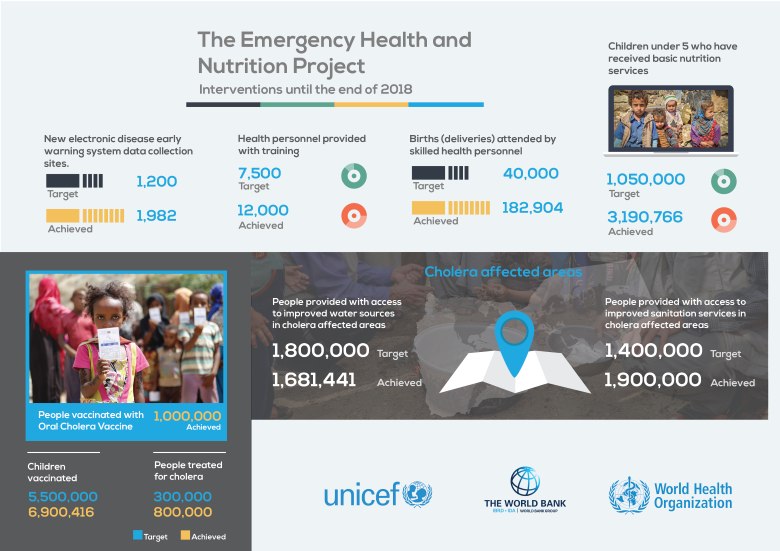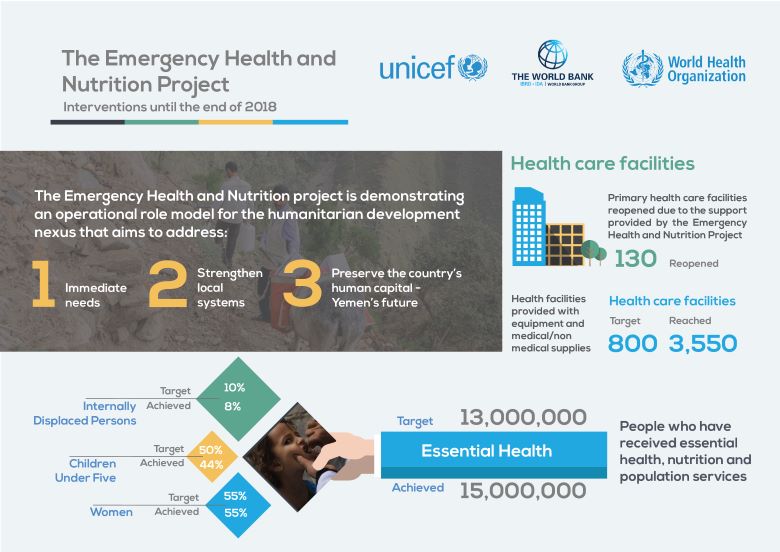For four years since the eruption of the conflict, Yemeni people have continued to suffer from the severe economic decline and the brunt of ongoing hostilities. In addition, changes in the frontlines and the collapsing essential public services have taken a massive toll on the Yemeni population, exacerbating chronic vulnerabilities. The health care system continues to be a victim of Yemen's conflict where poverty, hunger and unsafe drinking water have taken their toll. The already dire humanitarian situation in Yemen has been exacerbated by successive outbreaks of diseases such as cholera and diphtheria.
The Yemen Emergency Health and Nutrition Project (EHNP) aims to strengthen the delivery of basic health and essential nutrition and water and sanitation services as well as support and preserve the national implementation capacity by investing in the existing, local structure in the health and water and sanitation sectors, which will help maintain the main foundations for a speedy recovery in the post-conflict phase in the future.
The project builds on partnerships formed through past IDA-financed projects with two UN agencies – United Nations Children’s Fund (UNICEF) and the World Health Organization (WHO) – that have strong technical capacity, presence and experience in Yemen. The EHNP continues to be the main pillar in the international support system that provides vulnerable Yemenis with health, nutrition and water and sanitation services. Under the deteriorating operational environment and amidst challenges, the project is showing remarkable progress and results. With the approval by the Board of Executive Directors on May 14 of additional financing in the amount of US$200 million equivalent, IDA’s contribution towards the EHNP totals US$683 million dollars.

EHNP components
The EHNP activities are categorized in three components: (1) Improving Access to Health, Nutrition, Public Health and Water and Sanitation Services; (2) Project Support, Management, Evaluation and Administration; and (3) Contingent Emergency Response. The components and subcomponents are described in detail below.
Improving Access to Health, Nutrition, Public Health and Water and Sanitation Services supports the coverage of the Yemeni population with health and nutrition services and WASH services at both primary health care (PHC) level and at referral secondary care centers, as well as capacity building of the health and water and sanitation systems. The services are offered through the integration of the PHC model with the referral services, thus ensuring a continuum of care for the population.
Subcomponent 1.1 Strengthening the Integration of Primary Health Care Model, implemented by UNICEF, ensures the continued delivery of key health and nutrition services, including psychosocial support, at the PHC level through outreach/mobile teams, community-based interventions and PHC facilities, provides targeted food supplementation program, helps prepare for and prevent cholera, and facilitates community engagement to create demand for services.
Subcomponent 1.2 Supporting Health and Nutrition Services at the First Level Referral Centers, implemented by WHO, complements the PHC model and ensure the continuum of care at the referral centers and hospitals by supporting the management of severe acute malnutrition cases, basic/comprehensive emergency obstetric and neonatal care, management of cholera cases; management of non-communicable diseases and mental health and psychosocial support, and sustaining the national capacity of blood banks.
Subcomponent 1.3 Sustaining the National Health System Preparedness and Public Health Programs, implemented by WHO, supports nationwide public health programs such as vaccination campaigns, integrated nutrition surveillance system, epidemiological and diagnostic laboratory capacity and electronic disease early warning system.
Subcomponent 1.4 Improving Access to Water and Sanitation Services and Strengthening Local Systems, implemented by both UNICEF and WHO, aims to sustain the operationalization of water supply system and waste water treatment plants as well as strengthen the local water institutions to ensure sustainability of water, sanitation and hygiene promotion service delivery and support the prevention of and preparedness for future disease outbreaks.
To date, substantial results could be attributed to the EHNP, namely; (i) 3,550 health facilities receiving operating costs, basic health kits, and/or equipment and furniture; (ii) nearly 15,000 health personnel trained; (iii) 3.7 million women and children receiving nutrition services; (iv) about 700,000 successfully treated from cholera which brought the case fatality rate down from 2.3 to 0.2 percent, and thus saving thousands of lives; (v) 6.9 million children immunized (of which 5 million are under the age of five); and (vi) 630,583 women received antenatal care while 182,904 births were attended by skilled health professionals.
Project Support, Management, Evaluation and Administration supports project administration and monitoring and evaluation activities, including third-party monitoring, and technical assistance.
Contingent Emergency Response provides expedited response in the event of an emergency impacting public health. This component has been triggered twice to address rising malnutrition and the cholera epidemic in 2017.
System Building during Conflict
Despite the ongoing conflict and the challenging operating environment where 7.5 million Yemeni are in areas with medium to high access constraints, many beneficiaries have been reached through the EHNP. The EHNP is contributing to not only saving lives but also focusing on system building with a long-term view for development and reconstruction.
In addition to supporting the health and water and sanitation facilities through supplying operating costs and necessary commodities to maintain their functionality, capacity building of governorate and district health offices, health workers, and local water institutions has been supported. Furthermore, through the EHNP, innovation/use of technology for planning and monitoring activities on the ground is being explored, and national guidelines and action plans are agreed upon with the local authorities and other partners. Yemen is a good example where humanitarian-development nexus is operationalized.
